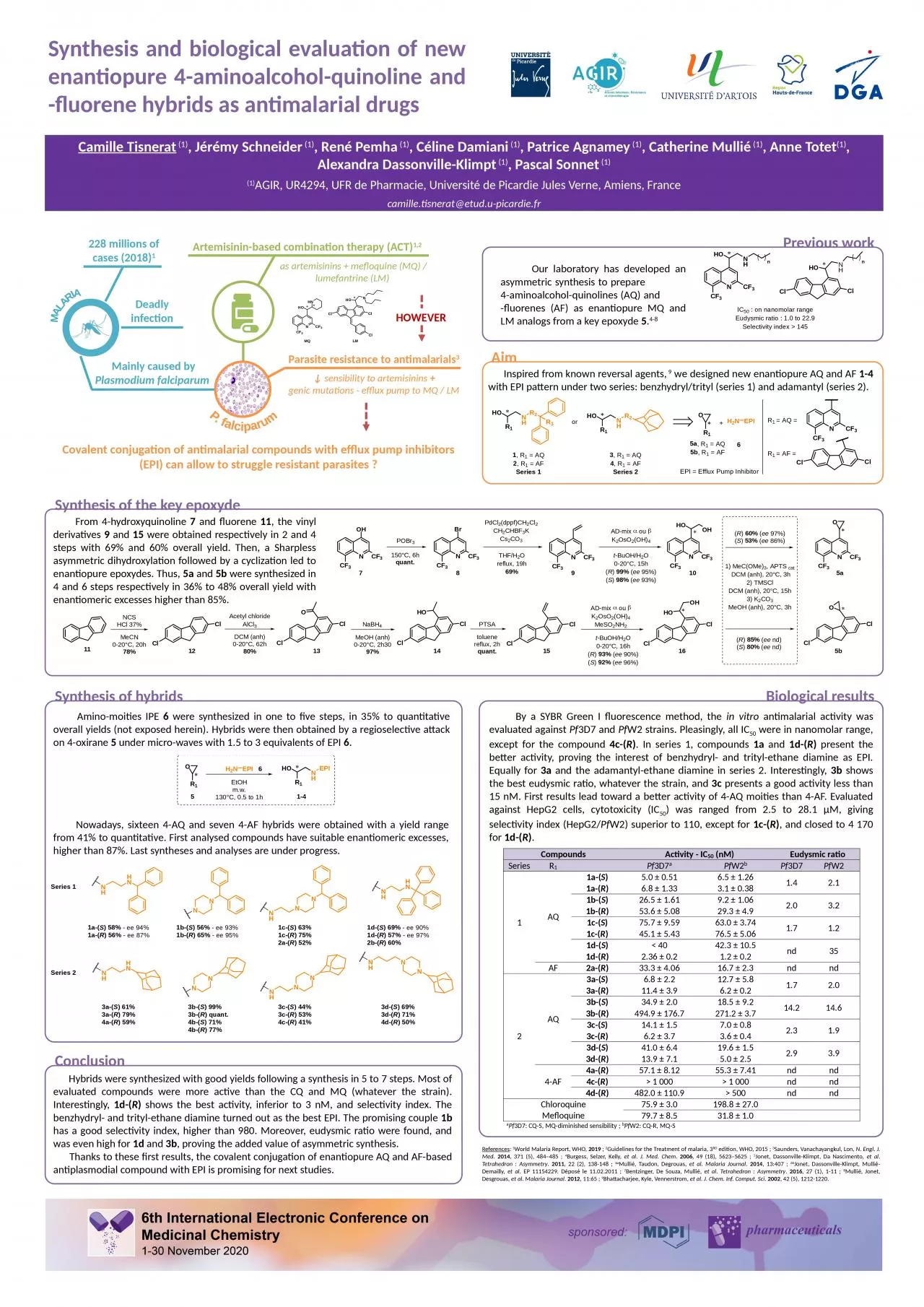

Camille Tisnerat 1 Jérémy Schneider 1 René Pemha 1 Céline Damiani 1 Patrice Agnamey 1 Catherine Mullié 1 Anne Totet 1 Alexandra DassonvilleKlimpt ID: 918928
Download Presentation The PPT/PDF document "Synthesis and biological evaluation of n..." is the property of its rightful owner. Permission is granted to download and print the materials on this web site for personal, non-commercial use only, and to display it on your personal computer provided you do not modify the materials and that you retain all copyright notices contained in the materials. By downloading content from our website, you accept the terms of this agreement.
Slide1
Synthesis and biological evaluation of new enantiopure 4-aminoalcohol-quinoline and -fluorene hybrids as antimalarial drugs
Camille Tisnerat (1), Jérémy Schneider (1), René Pemha (1), Céline Damiani (1), Patrice Agnamey (1), Catherine Mullié (1), Anne Totet(1), Alexandra Dassonville-Klimpt (1), Pascal Sonnet (1)(1)AGIR, UR4294, UFR de Pharmacie, Université de Picardie Jules Verne, Amiens, Francecamille.tisnerat@etud.u-picardie.fr
Synthesis
of the key
epoxyde
From
4-hydroxyquinoline
7
and
fluorene
11, the vinyl derivatives 9 and 15 were obtained respectively in 2 and 4 steps with 69% and 60% overall yield. Then, a Sharpless asymmetric dihydroxylation followed by a cyclization led to enantiopure epoxydes. Thus, 5a and 5b were synthesized in 4 and 6 steps respectively in 36% to 48% overall yield with enantiomeric excesses higher than 85%.
Synthesis
of hybrids
Amino-
moities
IPE 6 were synthesized in one to five steps, in 35% to quantitative overall yields (not exposed herein). Hybrids were then obtained by a regioselective attack on 4-oxirane 5 under micro-waves with 1.5 to 3 equivalents of EPI 6.
Biological
results
Conclusion
Hybrids
were synthesized with good yields following a synthesis in 5 to 7 steps. Most of evaluated compounds were more active than the CQ and MQ (whatever the strain). Interestingly, 1d-(R) shows the best activity, inferior to 3 nM, and selectivity index. The benzhydryl- and trityl-ethane diamine turned out as the best EPI. The promising couple 1b has a good selectivity index, higher than 980. Moreover, eudysmic ratio were found, and was even high for 1d and 3b, proving the added value of asymmetric synthesis. Thanks to these first results, the covalent conjugation of enantiopure AQ and AF-based antiplasmodial compound with EPI is promising for next studies.
References: 1World Malaria Report, WHO, 2019 ; 2Guidelines for the Treatment of malaria, 3RD edition, WHO, 2015 ; 3Saunders, Vanachayangkul, Lon, N. Engl. J. Med. 2014, 371 (5), 484–485 ; 4Burgess, Selzer, Kelly, et al. J. Med. Chem. 2006, 49 (18), 5623–5625 ; 5Jonet, Dassonville-Klimpt, Da Nascimento, et al. Tetrahedron : Asymmetry. 2011, 22 (2), 138-148 ; 6aMullié, Taudon, Degrouas, et al. Malaria Journal. 2014, 13:407 ; 6bJonet, Dassonville-Klimpt, Mullié-Demailly, et al. EP 11154229. Déposé le 11.02.2011 ; 7Bentzinger, De Souza, Mullié, et al. Tetrahedron : Asymmetry. 2016, 27 (1), 1-11 ; 8Mullié, Jonet, Desgrouas, et al. Malaria Journal. 2012, 11:65 ; 9Bhattacharjee, Kyle, Vennerstrom, et al. J. Chem. Inf. Comput. Sci. 2002, 42 (5), 1212-1220.
By a SYBR Green I fluorescence method, the in vitro antimalarial activity was evaluated against Pf3D7 and PfW2 strains. Pleasingly, all IC50 were in nanomolar range, except for the compound 4c-(R). In series 1, compounds 1a and 1d-(R) present the better activity, proving the interest of benzhydryl- and trityl-ethane diamine as EPI. Equally for 3a and the adamantyl-ethane diamine in series 2. Interestingly, 3b shows the best eudysmic ratio, whatever the strain, and 3c presents a good activity less than 15 nM. First results lead toward a better activity of 4-AQ moities than 4-AF. Evaluated against HepG2 cells, cytotoxicity (IC50) was ranged from 2.5 to 28.1 μM, giving selectivity index (HepG2/PfW2) superior to 110, except for 1c-(R), and closed to 4 170 for 1d-(R).
Nowadays
, sixteen 4-AQ and seven 4-AF hybrids were obtained with a yield range from 41% to quantitative. First analysed compounds have suitable enantiomeric excesses, higher than 87%. Last syntheses and analyses are under progress.
228 millions of cases (2018)
1
MALARIA
Deadly infection
Mainly
caused
by
Plasmodium falciparum
P. falciparum
Parasite
resistance
to antimalarials
3
Artemisinin-based
combination
therapy
(ACT)
1,2
HOWEVER
Covalent conjugation of antimalarial compounds with efflux pump inhibitors (EPI) can allow to struggle resistant parasites ?
as
artemisinins
+ mefloquine (MQ) / lumefantrine (LM)
↓
sensibility
to artemisinins +genic mutations - efflux pump to MQ / LM
Our laboratory has developed an asymmetric synthesis to prepare 4-aminoalcohol-quinolines (AQ) and -fluorenes (AF) as enantiopure MQ and LM analogs from a key
epoxyde 5.4-8
Previous
work
Aim
Inspired from known reversal agents,
9
w
e
designed
new
enantiopure AQ and AF
1-4
with EPI
pattern
under two series: benzhydryl/trityl (series 1) and
adamantyl
(series 2).